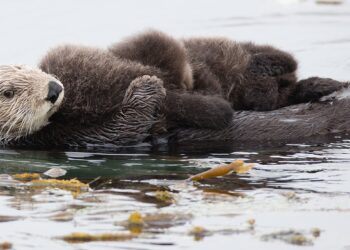
Imagine being a sea cow peacefully grazing on seagrass when suddenly, a massive crocodile lunges out of the murky depths. Before you can blink, you’re being dragged underwater, torn apart by the crocodile’s powerful jaws. And just when you think it can’t get any worse, a pack of hungry sharks circles in.
Such was the unfortunate fate of an ancient sea cow whose fossilized remains from nearly 20 million years ago recently revealed a horrifying prehistoric death. However, this fossil provided us insights into the complex food webs of the Miocene epoch.
A Gruesome End Uncovered
The discovery began when a farmer noticed unusual rocks south of Coro, Venezuela. Upon closer investigation, a team of international paleontologists called to the site found fossilized remains of a manatee-like creature, including parts of a skull and 18 vertebrae. These remains belonged to an extinct sea cow genus known as Culebratherium.
What was immediately evident were the many bite marks found across the skeleton. Interestingly, there were three distinct types of bite marks. One bite type revealed that a crocodile first attacked the sea cow. The teeth marks suggested the predator had grabbed its prey by the snout, possibly to suffocate it. Further marks indicated the crocodile likely performed a “death roll,” a violent spinning maneuver still used by modern crocodiles to subdue their prey.

“Initially, we were unfamiliar with the site’s geology, and the first fossils we unearthed were parts of skulls. It took us some time to determine what they were — sea cow skulls, which are quite peculiar in appearance,” said Marcelo Sanchez-Villagra, who is the Director of the Palaeontological Institute & Museum at Zurich and co-author of the new study.
After the crocodile finished, one or multiple tiger sharks (Galeocerdo aduncus) scavenged the remains, leaving behind tooth marks and even a tooth embedded in the sea cow’s neck.
Reconstructing a Prehistoric Food Chain
This fossil find is significant because it offers a rare example of multiple predators feeding on the same prey, something not often seen by paleontologists. Previous research has noted other ancient marine animals, like sperm whales, were scavenged by multiple predators. This new finding suggests that sea cows were also an important food source in these ancient food chains.
“Today, we often see predators feeding on the same carcass in the wild, but finding such evidence in fossils is much rarer,” explained Aldo Benites-Palomino, a paleontologist at the University of Zurich.
The researchers analyzed the sediment around the site to determine the age of the fossils, dating them to the Early to Middle Miocene epoch, about 20 million years ago. This era was a time of significant evolution and diversification in marine ecosystems. It saw the rise of early cetaceans, including the ancestors of modern whales and dolphins. Additionally, various species of sharks, such as the now-extinct Megalodon and the ancestor of today’s great white shark, evolved new predatory strategies and became apex predators. Coral reefs also expanded dramatically, providing complex habitats that supported a wide variety of fish, mollusks, and crustaceans.
Ancient sea cows, such as those from the extinct genus Culebratherium — a relative of the modern dugong and manatee — were marine herbivores that roamed warm, shallow waters millions of years ago. Much like their present-day counterparts, these prehistoric creatures had elongated, torpedo-shaped bodies adapted for a life spent primarily in water. They possessed paddle-like front limbs and a horizontal, fluked tail that helped them navigate through coastal seagrass beds, their primary feeding grounds.
Sea Cows Across the Ages
Unlike today’s dugongs, ancient sea cows often had larger, more robust bodies with thicker bones, which provided ballast to counteract buoyancy while foraging on the seafloor. Their skulls were specially adapted to support a muscular snout and strong lips, allowing them to graze efficiently on aquatic vegetation.
Modern sea cows, such as manatees and dugongs, have few natural predators due to their large size and relatively slow movements. However, during the rare occasions that they are attacked, their primary threats come from apex predators like sharks and crocodiles. Large shark species, such as bull sharks and tiger sharks, are known to prey on manatees, especially in areas where their habitats overlap, like the warm coastal waters of the Gulf of Mexico and the Indian Ocean. Saltwater crocodiles may also sometimes target sea cows. The new finding shows that complex predator-prey relationships, similar to those observed today, already existed millions of years ago.
Despite these natural predators, human activities pose the greatest threat to sea cows, with boat strikes, habitat loss, and entanglement in fishing gear contributing to a steep decline in their populations.
The new findings appeared in the Journal of Vertebrate Paleontology.






